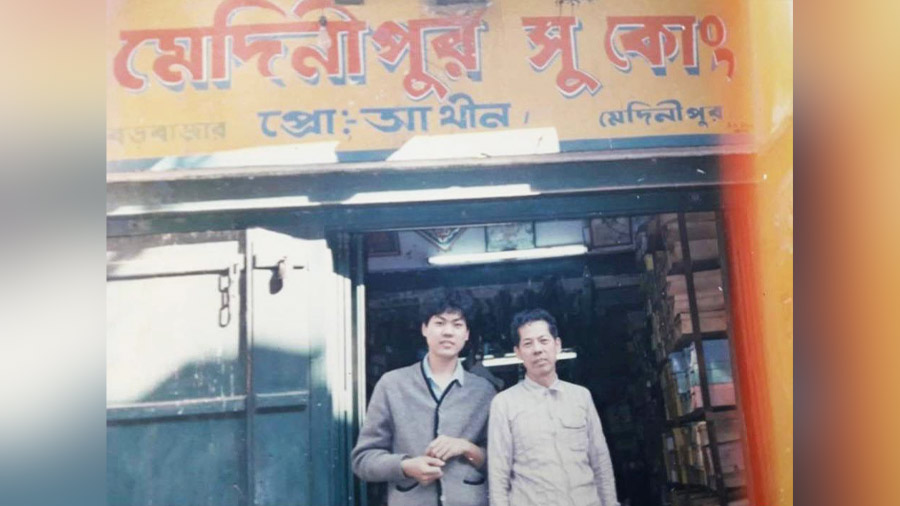It is finally that time of the year. Maa aschhen has turned into Maa eshe gechhen. But, while Maa is home, many are not. And they are missing baarir pujo, desher pujo, trying to sneak some of the pujo vibes in parobash. They are trying to build a home away from home, coming together to celebrate Durga Puja.
My Kolkata got in touch with probashi bangalis from 60-20, to know about their most etched Durga Puja memory outside India, and the Bongs poured their heart out. Full disclaimer, the memories will make your eyes moist and will make you drop a text to every probashi Bangali you know. We pray, may everyone who is away from home on the festive days, find their way back home next pujo. Aasche bachhor, aabar hobe.
Finding the joy of ‘Pujo-r chhuti’ in the US
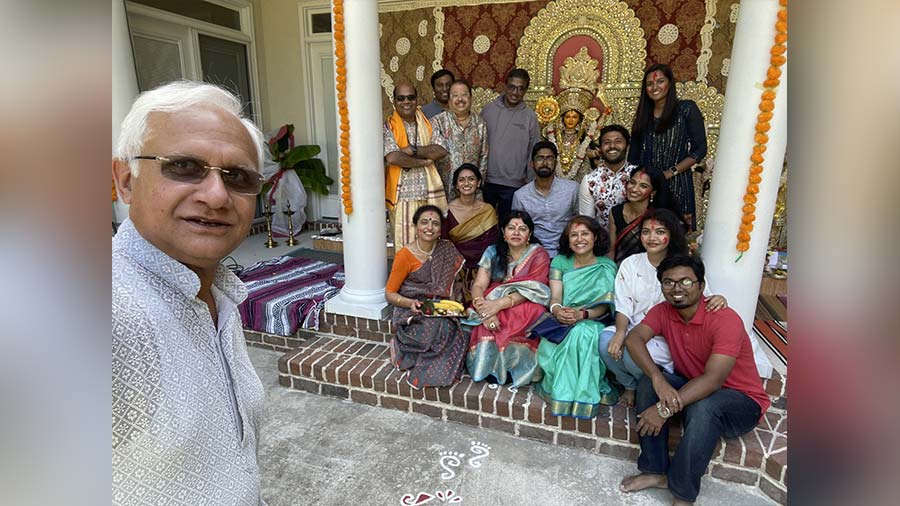
The small group who organise a Puja in their backyard in Savannah Photograph courtesy: Shubhra Mukherjee
Pujo for probashis is a completely different experience and involvement. I have been a probashi Bangali since 1987 — first living in Mumbai and then Savannah in Georgia (USA) — and I can vouch that the level of participation in our probashi pujos is intense!
Goddess Durga is embedded in Bengali genes, no matter where we are. So, in 2013 when I landed in Savannah and realised that this city has no experience of Durga Puja, I was sad. However, as I said, Durga Maa is in our genes, and perhaps we are in hers too. The very next year, my cousin, whom I reconnected with after decades, got me involved in the Durga Puja which he started in his own home.
Since then, till date, the memories are growing but the involvement and passion is unprecedented! So what if we don’t get pujor chhuti, we still do the pujo and convert our weekends to pujor chhuti.
Whatever be it, Maa has to come to us and She does! We squeeze the four days to two but She doesn’t mind. She really comes to us as our Mother. At Statesboro in Dr Aniruddha Mitra’s house, our memories of Durga Puja keep piling and every year our albums get loaded.
— Shubhra Mukherjee, 64, Savannah, Georgia, USA
A Durga Puja tradition in Singapore
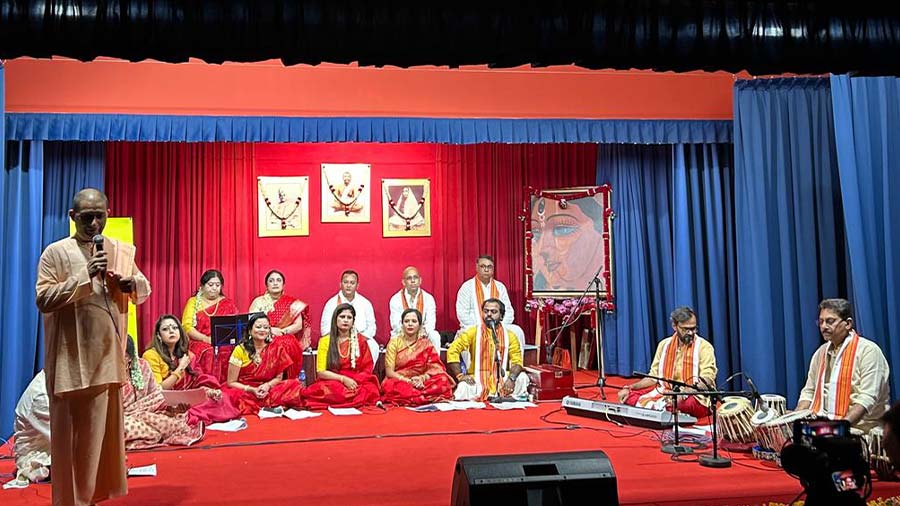
Mahalaya event at Ramakrishna Mission, Singapore, on October 14, 2023 Photograph courtesy: Mrs Kundu
I have been a probashi Bangali for a few decades now. One of the fond memories I have of Durga Puja abroad is the Houston Durga Bari Puja (Texas, USA). Their idol is beautiful, and you just want to go and stare at it. There is often a queue outside the entrance of the temple venue and that in itself is such an interesting thing for a probashi pujo.
We moved to Singapore in 2002, and at that time there was one pujo, organised by the Bengali Association of Singapore (BAS). It is a pujo we’re still associated with and visit every year, but now there are about seven Durga Pujas that happen all around the city. Every year, we usually drop in for a visit at many of the pujos — Singapore being a small place, most of these are quite close to each other. An interesting aspect of the BAS pujo is that all the ladies who cook and serve bhog wear the same colour saris — makes for a rather wonderful picture when they all get on stage to serve the bhog to Durga. There is usually a dhunuchi naach as well, and since Bharatnatyam is a popular dance in Singapore, there are performances by classical dancers. Almost every year, Maalika Panicker (a well-known Bharatnatyam dancer-choreographer who identifies as trans) puts up a performance we look forward to.
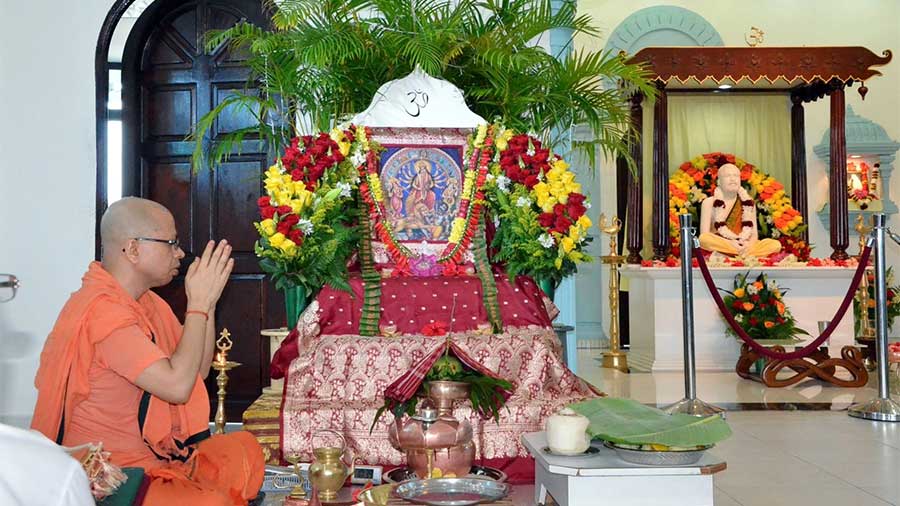
Durga Puja at Ramakrishna Mission, Singapore Photograph courtesy: Mrs Kundu
The one tradition of sorts that I have for Durga Puja in Singapore is visiting the pujo at the Ramkrishna Mission here. I usually try to be there for every pujo if I am in town. There was no Puja here for two years due to the pandemic but this year I visited for Mahalaya. This year’s Mahalaya was held at RKM in the evening — the venues change depending on availability. Every year, on all the days of Puja, there is a paath and bhajans and songs at the Mission, and the vibrations of the place is something that soothes me. Interestingly, there is no idol, the Puja happens with a photo of the goddess. I go there for the atmosphere.
The other favourite festive thing in Singapore for me is attending the Navratri celebrations. There are many south Indian temples here that organise huge Navratri celebrations, including bhog and dandiya, which is very popular here. I love those celebrations and always make it a point to visit.
— Mrs Kundu, 54, Singapore
Introducing the little one to Durga Puja in faraway Germany
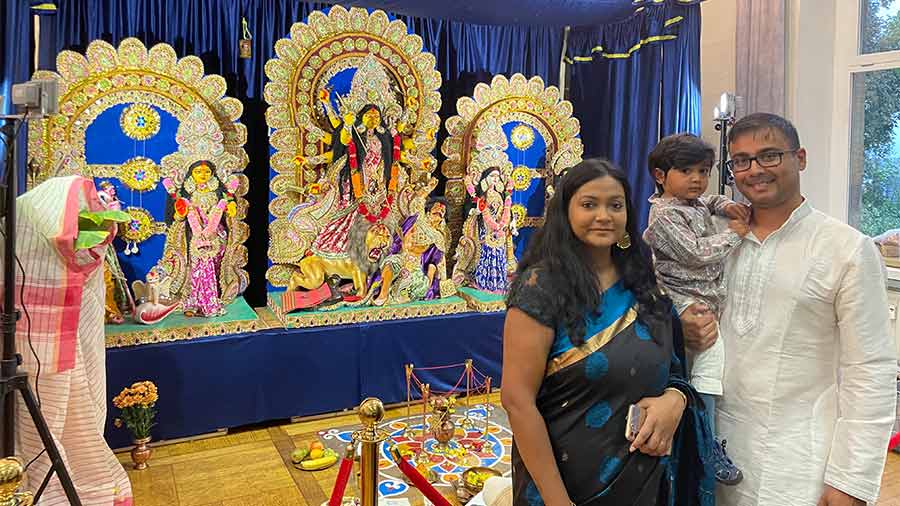
Rupam, Sayani and their son at a Durga Puja in Germany Photograph courtesy: Rupam Roy
Growing up in the alleys of Kolkata, Durga Puja was always an integral and incessant part of infanthood and childhood. When the alleys changed from Kolkata to elsewhere in India due to higher education and work engagements, I used to smell the October air and it still used to remind me of my childhood.
But now the October air in Germany is heavy with the fragrance of the falling leaves and hardly has any tropical smell in it that might remotely bear a connotation to what I was accustomed to in larger parts of India. Therefore, here in the deep south of Germany, we have turned to community organised pujas that might make up for that missing flavour (the smell is albeit missing).
Now that we have also welcomed our offspring and that the puja of 2021 was his first puja abroad, we try to instil the essence of being a Bengali through our participation. Dress and food being the two most intricate Bengali sentiments associated with Puja, and we try to be bounty with these.
— Rupam Roy, 39, Baden Waghäusel, Germany
My 7-year-old girl has the energy to sit through 3 hours of Kumari Pujo
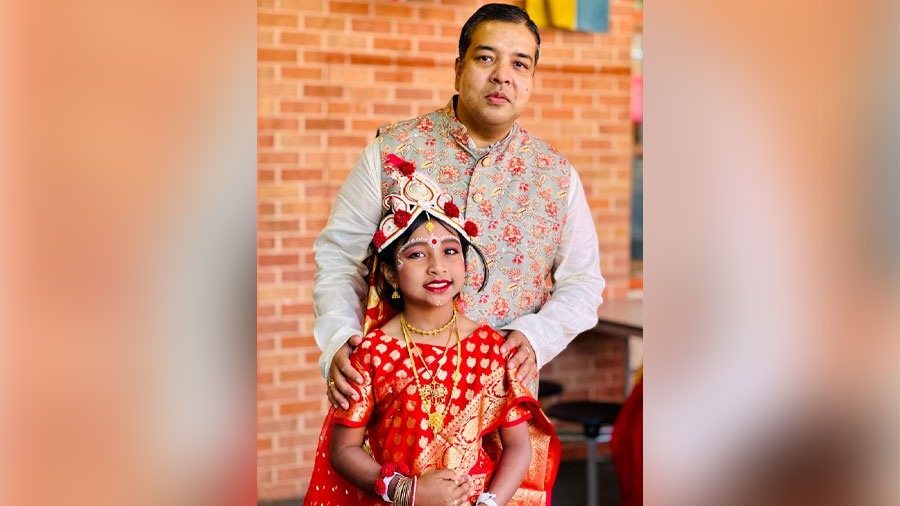
Avishek and Myra before Kumari Pujo at Central Texas Bengali Association Durga Puja in 2022 Photograph courtesy: Avishek Mukherjee
Last year, our younger daughter, Myra Mukherjee, played the ‘kumari’ in the Kumari Pujo of Central Texas Bengali Association pujo in Austin. Myra loved the saju guju for the event and posed for all photographers.
Our family was stressed with shipping the sarees and accessories from India and whether Myra would sit through the whole ceremony. We were overjoyed to see how much Myra and her sister Ayesha were involved throughout the whole Kumari pujo programme and enjoyed every moment. Our family is very involved in pujo with cooking bhog, participating in cultural programmes and also helping with serving food during lunches. Durga Pujo is generally a weekend affair in Austin and most other places in the USA and generally celebrated by renting facilities in local schools.
I think it is more involved than I have ever been in Kolkata pujo. Back home I was mostly figuring out what to wear from Saptami to Doshomi and where to eat!
Here, we have rehearsals for two-three months for dance, drama and songs. Plus building Mandap and figuring out all the logistics. It’s real dedication from Pujo pagol Bengalis!
— Avishek Mukherjee, 44, Austin, Texas, USA
Home is where the heart is and my heart is anywhere you are
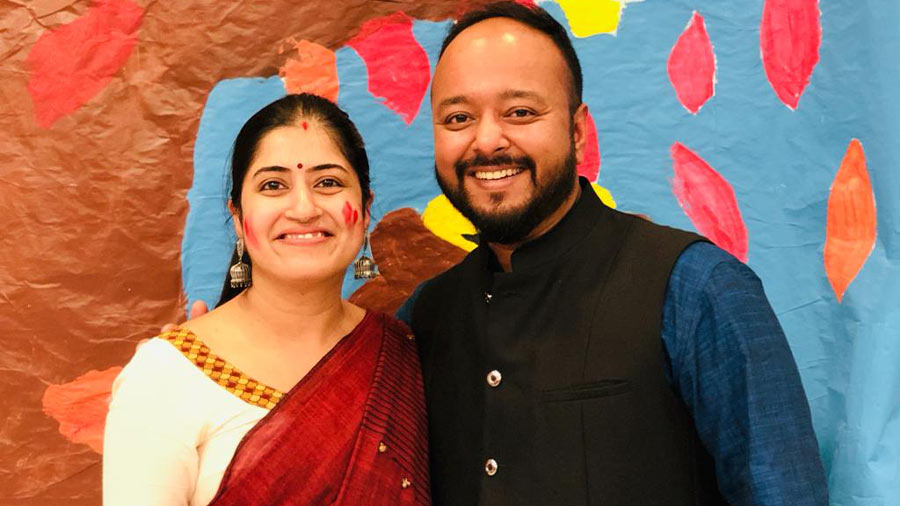
Ballari Maitra and Sinjan Dhar
An Elvis classic summing our nomadic lives. Our lives have taken us from different cities to different countries and we always looked forward to celebrating Durga Pujo. The festive vibes of Durga Pujo, while not even close to the sheer celebration back home, are always an amazing feeling to be part of the euphoria in different places we call our “Home”.
Be it the humble celebrations in the suburbs of Michigan or to more elaborate settings in greater Toronto, Pujo meant we could relive our childhood memories by participating in the festivities. From ethnic wear, to huddling with friends - from feasting on Bengali delicacies to playing dhak during sandhya arati, we always look forward to celebrating Durga Pujo no matter where we are.
2019 Durga Puja was the last pujo celebration in Michigan before Covid hit us. This pujo was special- what reminds me most is playing dhak together with dhols that were brought in for bishorjon. The cheers of ashche bochor abar hobe with unison of dhaks and dhols playing together filled the pandals with euphoria.
— Ballari Maitra and Sinjan Dhar, 38, Toronto, Canada
‘Parobashey pujo’ musing and a love-lorn ballad to home
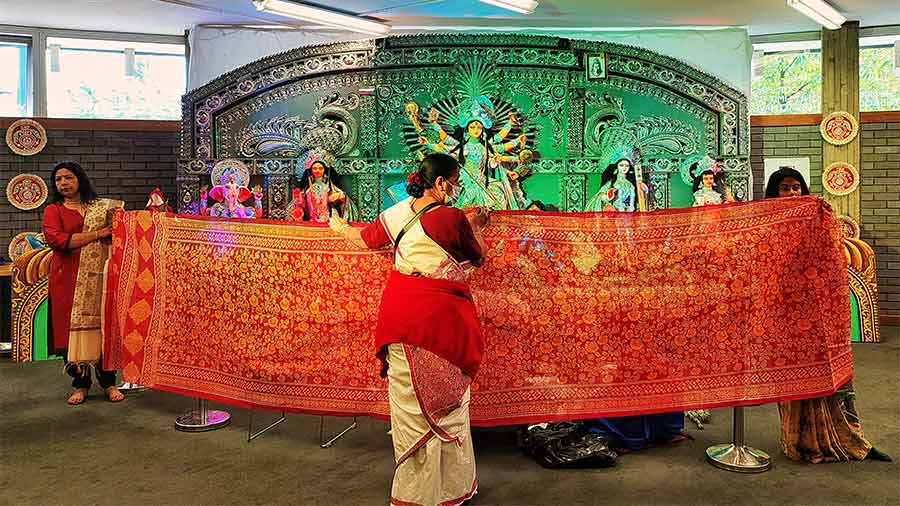
A glimpse of a Durga Puja in London Photograph courtesy: Hrishit Banerjee
It has been a while now that I have experienced pujo, as we Bengalis like to call it, anywhere at all. Having left my home, family and friends in my city (Kolkata) way back in the summer of 2018, I have never really felt the urge to experience pujo abroad. Not being a religious person, to me pujo represented different things, almost all aspects of which were missing in the grand attempts of various Bengali/ Indian associations in the various countries I have resided in. To me pujo is all about coming home, meeting friends and family, going on photowalks trying to capture fleeting glimpses of the wonderful carnival of art in my city. The food that you crave all year round, and yet which gives you such fantastic acid reflux. Pujo to me is all about the spirit of my city, unbound and indomitable. Pujo is music, pujo is shiuli phool. Pujo is Mahishasuramardini at 4 o’clock in the morning.
I did go to the famous London pujos back in 2021. They do a marvellous job in terms of capturing all the religious aspects. Quite a fitting worship of Devi, large gathering, beautiful idols — a festival celebrated in all grandeur. Surely enjoyable to the many multitudes who gather there.
If only I could belong there…
— Hrishit Banerjee, 35, Cambridge, United Kingdom
Finding ‘bhog’, ‘mishti doi’ and a slice of home away from home
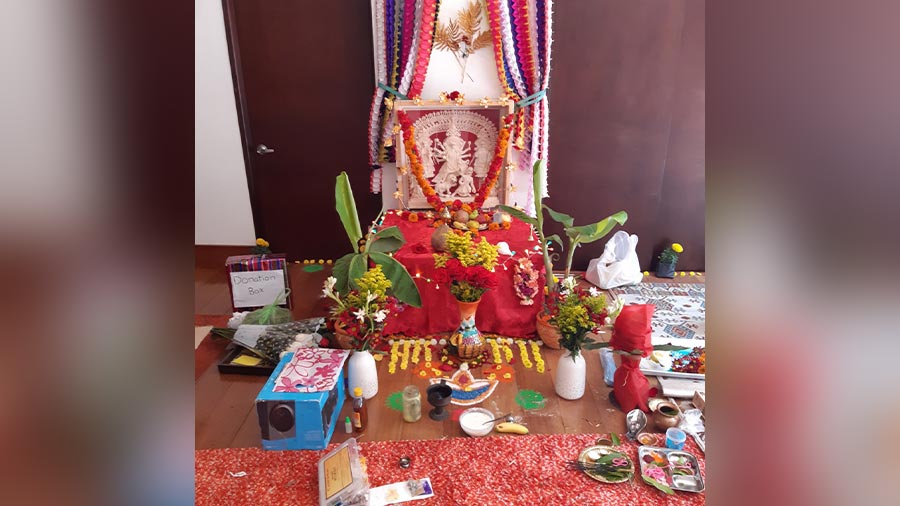
A glimpse of a Durga Puja in Colombia Photograph courtesy: Basabendu Barman
In October 2021, I experienced Durga Pujo in a new way - far from home in Bogota, Colombia. The local Indian association in Bogota usually organises Pujo for two days, typically on a Saturday and Sunday. Before this, I had only seen people in photos and videos, dressed in traditional Indian attire, dancing, or standing with smiles in semi-crowded Pujo pandals in the United States. I always thought it would be nice to attend a pujo without the usual sweaty crowds, frustrated volunteers, and traffic.
However, when I arrived at the event on that Sunday morning, it was quite different from what I had imagined. It wasn't a pandal but rather a spacious and well-decorated hall with a small idol in one corner. To be honest, I was not just disappointed; I was truly heartbroken. There were many people, not just Indians, and they seemed busy with various tasks like arranging food and sorting out issues with the air conditioning. I stayed for a while and learned that there would be an evening sondhe arati with cultural events, but unfortunately, I couldn't attend. On the bright side, the food (bhog) they served was exceptional, and I was amazed at how they managed to provide such delicious mishti doi in South America.
While everyone was friendly and welcoming, the overall atmosphere was quite different – it felt more like a fine dining restaurant, very professional. I think the essence of the pujo isn't just about the idol or the pandal; it's rather the pujo asche vibe and the bustling crowd, which, oddly enough, I had always tried to avoid.
— Basabendu Barman, 34, Bogota, Colombia
Reinventing Durga Puja, Rabindranath and the idea of ‘parobash’ during Covid

A glimpse of a Durga Puja in Illinois Photograph courtesy: Bhaskar Mondal
Travelling halfway across the world, I knew life would be different. How different? I didn’t know. But as time went by and I settled with my life here in Illinois, I would sometimes think about the years back in India. It seemed like a different life altogether. Same goes for pujo. From WhatsApp stories of friends, I just realised it was Mahalaya yesterday, bringing back decade old memories.
I came to the USA during Covid times. Finally, after the restrictions eased, we celebrated Durga Puja in Urbana, Illinois, in the fall of 2022 – my first proper pujo in this country. There was no pandal-hopping, no smell of chhuti and homecoming in the atmosphere, life just seemed as usual. We had one Durga Puja in our little town, that too conveniently placed during the weekend - from Friday evening to Sunday. And the venue was the historical Channing Murray Foundation, where Rabindranath Tagore gave his first public speech in the USA. One step inside, and I was transported back home! A spell of magic inside the hall. The weekend was filled with good food, adda, and music!
— Bhaskar Mondal, 26, Urbana, Illinois, USA


